Beautiful Bukhara is filled with tile-clad mosques, a bustling bazaar, and ancient winding streets that have seen the likes of Alexander the Great and Genghis Khan. There are a surprising amount of things to do in Bukhara, making a two-day trip to this little city an absolute must on your Uzbekistan itinerary!
Bukhara is the capital of the Bukhara Province in Uzbekistan. Located smack in the middle between Khiva and Samarkand. Filled with over 150 monuments and classified by UNESCO as one of the most complete examples of medieval cities in Central Asia, a trip to Bukhara will leave you mesmerized!
We spent two full days exploring Bukhara at the beginning of a cold November month. The cold had us layering all the clothes we packed and darting in and out of little restaurants for a cup of hot choy (tea). Perhaps not the best month to visit Bukhara, but more on that later on!
This comprehensive Bukhara travel guide will run you through the very best things to do and see both inside and around Bukhara, how to get the Bukhara, where to stay and anything else you need to start planning the perfect trip!
Please note: This post contains affiliate links, meaning I may earn a commission if you make a purchase by clicking a link (at no extra cost to you). Learn more.


Visiting Bukhara travel essentials
WHERE TO STAY
- Best Location ($) Rizo Boutique Hotel
- Locally flavor ($$) Komil Bukhara Boutique
- Best ammenities ($$) Boutique Hotel Minzifa
TRAVEL RESOURCES

Uzbekistan tours including Bukhara
Traveling through Uzbekistan without an organized tour is relatively easy. Public transportation is efficient, locals are eager to help, and accommodations are a dime a dozen. Therefore I highly recommend exploring Uzbekistan without a guided tour. If however, that is of no interest to you, have a look at the following Uzbekistan tours that include Samarkand.
8 Days Uzbekistan Tour: Includes a visit to Tashkent, Khiva, Bukhara, and Samarkand with a guide. Also has the option of canceling free of charge 7 days prior to departure
7 days Golden Ring Uzbekistan Tour: Includes visits to Tashkent, Khiva, Bukhara
and Samarkand with a guide as well as the train tickets and flights between Tashkent and Khiva.

Practical details for a trip to Bukhara
All prices indicated in this Bukhara travel guide are in Uzbekistani som (UZS) and reflect the prices of travel in 2022.
To navigate around Samarkand download maps.me which is more reliable than Google Maps in Uzbekistan and works perfectly offline too.
Tip: Invest in a very affordable private city tour of Bukhara. This top-rated tour will show you all the major sites around Bukhara and provide you with plenty of local insights.
How many days to visit Bukhara
There is a lot to see both in and around Bukhara. Two full days to explore the main highlights of Bukhara is an absolute must. The city is relatively small so despite the seemingly large amount of sights, you can easily pack in a few together in one day.
Best time of the year for Bukhara Tourism
The best months to visit Uzbekistan are without a doubt April to mid-June and September through to mid-October. In March temperatures start slowly rising (13°C/ 55°F), until the middle of June they are comfortable enough to explore (34°C/ 59°F). September marks a cooling down from the overwhelming summer heat with a pleasant 28°C/ 82°F.
Our trip to Bukhara was at the end of October, and while we had Bukhara to ourselves it truly was very cold. If you do decide to visit end of October, beginning of November bring plenty of warm clothes.
How to get around Bukhara
The main Bukhara attractions are within walking distance from each other. We walked everywhere (bring comfortable footwear!). The only exception was the taxi we took from the Bukhara train station to our accommodation in Old Town Bukhara.
Getting from the station to the center of Bukhara should cost no more than 12,000 UZS ($1.06). The taxi ride takes 10 to 15 minutes. Taxis are located right outside of the exit of the train station. We got to Bukhara at night and were met with a wall of taxi drivers, all trying to sell us their services at very high prices, after a bit of haggling we agreed upon a price and were on our way.
Good to know: A taxi ride from the train station (new city) to Old Town will set you back around 20,000 UZS ($1.8) and takes 25 min.


A brief introduction and history of Bukhara
The city of Bukhara has a long and lustrous history dating back over 2000 years. As is the case for most of Uzbekistan, the Kingdom of Bukhara grew in importance as a trading post along the Silk Route. The strategic location meant that together with Khiva and Samarkand it was often the subject of sieges: Persians, Mongols, Turks, and even Alexandre the Great all marched through the Kingdom.
Despite the somewhat volatile situation, Bukhara grew to become one of the most important Islamic centers in all of Central Asia between the 9th and 16th centuries. The importance of Bukhara as a cultural, religious, and trade center meant that by the 16th century, the city was flush with scholars & merchants. The bazaars contained exotic spices, camels, and treasures from all along the Silk Route.
Money flowed freely into the city, evidence of which can still be found today in the extraordinarily well-preserved old city of Bukhara. The bustling bazaars with foreign items have now made way for tourist stalls and haggling vendors, the colorful madrassahs which once held up to 80 students have now fallen into slight disarray.
The overall old town could use a little extra 21st-century love, but the peeling paint and cracked facades create authenticity in an otherwise museum-like city.

Bukhara itinerary overview
This sample itinerary for Bukhara allows you to visit all the highlights beautiful Bukhara has to offer. It will mean a fair amount of walking, so be sure to bring comfortable walking shoes.
Day One: Mir-i-Arab Madrassah, Abdulaziz Khan Madrassah, Chor Minor Madrassah, Poi Kalon Ensemble, sunset drinks & dinner at Chasmai Mirob
Day Two: Chor Bakr Memorial Complex, Bolo Hauz Mosque, Ark of Bukhara, Bukhara Bazaar, Tower of Bukhara at sunset
7 things to do in Bukhara
There are a lot of places to see in Bukhara, keeping in mind your two-day Bukhara itinerary, I chose to highlight seven of my favorite places. They can be easily visited in one day, though it might be a bit rushed.
If you scroll down, I added a section containing 5 additional places to see. These however are located outside of Historical Bukhara, all except the Chor Bakr Memorial Complex are within walking distance from Poi Kalon (the beating heart of old Bukhara).

1. Spot the Chinese dragon in the tiles of the Abdulaziz-Khan Madrassah
The Abdulaziz Khan Madrassah is located just opposite the Ulugh Beg Madrassah, a stone’s throw away from the Bukhara Bazaar. This is the best place in Bukhara to visit to see a truly colorful Madrassah. Built in the 17th century, the Iwan gateway of the madrassah is very similar to the architecture found in Iran. It is however more colorful & intricate than its Iranian counterpart.
Take a closer look and you will notice the shapes are not entirely geometrical and are decorated with a playful plant pattern that snakes up the sides of the building. Try and see if you can find the Chinese dragon that is hidden in the pattern. A wink to the rich history of Bukhara and the important role it played on the Silk Route.
At the little ticket booth (inside) make a sharp right and walk towards the winter mosque. You have the option to get a (brief) tour with an explanation about the winter mosque (included in the entrance ticket) or simply enjoy the stunning architecture: Intricately carved reliefs, tile, brick mosaics, and painted ceiling panels, unlike anything you will see anywhere else in Bukhara.
Location: About a 4 min walk from the Kalon Minaret
Entrance Fee: 13,000 UZS ($1.2) for the mosque + a small additional fee to visit the winter mosque
Opening hours: 09.00 AM – 06.00 PM

2. Visit the oldest madrassah in Central Asia: Ulugh Beg Madrassah
After visiting the colorful Abdulaziz-Khan Madrassah, head over to the Ulugbek Madrassah which is conveniently located right on the opposite side of the road. You would not say so by its appearance, but the Ulugh Beg Madrassah is one of the oldest Madrassah in Central Asia. It is named after Sultan Ulugh Beg who was both a ruler and illustrious scholar.
Sultan Ulugh Beg had the Madrassah built during his rule in the 15th century according to the prevailing architecture (think picture-perfect geometry and 50 shades of blue tiles). It held up to 80 students during its heyday. Students would study everything from astronomy & Arabic to religious studies.
The Madrassah houses a variety of different tourist stalls today. Sadly it has fallen into a little bit of disarray, but do not let that deter you from visiting.
Location: About a 4 min walk from the Kalon Minaret
Entrance Fee: Free
Opening hours: 09.00 AM – 06.00 PM

3. Take in the arches at the Nadir Divan-Begi Madrassah
Built in the 17th century by the maternal uncle of the then-Khan. The outside of the building is a wonderful mixture of blue tiles, covered with a mix mash of different patterns (floral, plants, and animals). As is the case with the aforementioned Abdulaziz-Khan Madrassah, the influence of Bukhara as an important trading post along the Silk Route and the sub-sequential outside influences are clearly visible in the artwork on the tiles.
Interestingly enough, the inside of the building is a bit different from what you would traditionally expect when seeing a madrassah. The intricately carved Iwan opposite the entrance is missing as is the classroom for the students that usually line the walls. Instead, the inside looks very much like a Caravanserai (a traditional hotel for traders along the Silk Route).
There are multiple stories going around as to why this is the case but most likely the original objective of this building was indeed to be a Caravanserai and not a madrassah at all!
Location: About a 15 min walk from the Kalon Minaret
Entrance fee: Free
Opening hours: 08.00 AM – 05.00 PM

4. Go on a treasure hunt in the Bukhara bazaar
Traditionally this place would be bustling with traders from Europe and Asia displaying their goods. As Bukhara was an important stop along the Silk Route the bazaar was filled with all sorts of exciting items. These days the bazaar is still bustling, however, the goods are slightly less exotic and more focused on the tourists than anything else.
However, if you are looking to purchase a traditional souvenir, this would be the place to go. There are plenty of ceramics, suzanis, carpets, or carved woodwork items to choose from. For the more adventurous souls, you can add going on a hunt to find the Aladdin genie in one of the millions of oil lamps on display. Let me know if you find that genie!
Keep in mind that payment is in cash only, and you will need to bargain. As a general rule of thumb, you want to bring down the price by a good 20%.
What souvenirs to purchase: Ceramics, carved wood, Bukhara carpets, and Bukhara Suzani
Location: About a 3 min walk from the Kalon Minaret
Opening hours: Opens from around 09.00, though hours can vary depending on the season.
Good to know: Only cash is accepted

5. Visit the oldest building in Bukhara: The Ark of Bukhara
The Ark of Bukhara (sometimes referred to as the Fortress of Bukhara due to its massive walls) is the oldest structure in Bukhara. The original structure dates back to the 5th century AD, however, it has been built & rebuilt many times over the centuries and little of the original structure is left. The Ark was inhabited from the 5th century all the way up to the 1920s by important members of the Bukhara society including the Emir of Bukhara.
When walking around the Ark you will notice a few interesting architectural feats: Rising high above the entrance is the Juma mosque and all around the Ark you can find an interesting thick conical-shaped wall. The square surrounding the Ark played an important role in medieval Bukhara. Merchants who did not have a stall in the Bukhara bazaar would come here to trade their goods.
If you have some spare time, consider paying the entrance fee to have a little wander around the small museum that displays the history of Bukhara. Personally, I found the outside a lot more interesting to walk around like the inside of the once prominent fortress is mostly in ruins.
Location: About a 15 min walk from the Kalon Minaret
Entrance Fee: 15,000 UZS ($1.5) entry plus 5,000 UZS ($0.5) camera fee.
Opening hours: 08.00 AM – 05.00 PM, closed Wednesday

6. Get lost in the marvelous Poi Kalon Ensemble
The Poi Kalon Ensemble is the Islamic religious complex located smack in the middle of historical Bukhara. This is a square that will have you catching your breath from the minute you step foot in it, until the second you decide to leave (which will not be for many hours later).
The square has been the site of historical buildings since the 8th century BC, some of them worn down due to time others burned at the hands of conquered such as Genghis Khan. It holds three of the most beautiful buildings in the city.
Great Minaret of the Kalon
Lovingly known as the tower of death. This minaret reportedly withstood an invasion of Genghis Khan and stands as a beacon high above the city. It is a ‘mere’ 46 meters tall, and in ancient times would be used for the double purpose of calling people to prayer or punishing criminals by pushing them off the minaret to their untimely deaths.
This minaret was both a useful instrument and a slightly gruesome one at the same time. It is not possible to climb the staircase within the minaret these days, but nevertheless still a site worth viewing.
Tip: The minaret is a great point of reference if you get lost in old Bukhara.


Kalan Mosque
Built and rebuilt over the centuries, the Kalan mosque is a beautiful piece of architecture that has been the main mosque of Bukhara for over 500 years. It stands on the central square opposite the Miri Arab Madrassah and to the right of the Kalon Minaret. This particular version of the mosque dates back to the 16th century.
The inner courtyard is vast, with an astounding 288 domes and no less than 208 pillars. It was built to put its rival city of Samarkand to shame and to give Bukhara a bit of royal flair. Current day, this mosque is still in use and one of the few places that have not been submerged under tourist stalls (vendors).
Entrance Fee: 15,000 UZS ($1.2) – valid for 2 days
Opening hours: 08.00 AM – 05.00 PM
What to wear: Dress modestly (covering up elbows and knees for women)
Miri Arab Madrassah
Built in the 16th century according to the traditional architecture prevalent in Central Asia at the time. Think glazed mosaics, calligraphy across the entrance, and many geometrical shapes and patterns woven into the design. Similar architecture can be found across Iran and Afghanistan.
Contrary to the traditions at the time, this madrassah was not funded by taxes from the booming (silk road) trade but rather from the sale of 3000 Shia (Iranian) slaves. Inside you will find a statue of Ubaydulla (the emir ruling the city in the 16th century) as well as a myriad of little rooms dotted around the main square which was, and still are, the rooms of the many students of the school.
Yes, you read that correctly this madrassah is still functioning 500 years after it was erected. In fact, during Soviet rule, it was the only mosque allowed to practice in the city.
How to get there: Located on the central Poi Kalon Square
Good to know: Sadly you cannot enter this madrassah. You can venture inside and have a look at the architecture that is hidden behind wooden latticework

7. Grab a drink and watch the sunset over the Poi Kalon Ensemble from the Cafe Chasmai Mirob
This little café offers exquisite views over the Poi Kalon ensemble. It is one of the best places in Bukhara to enjoy the sunset with a drink and something to nibble on.
The café offers vegetarian food as well as a variety of local dishes and even some decent-tasting wine. Most importantly it has a beautiful terrace which is perfect on a summer evening to catch the sunset behind the Kalon minaret.
Location: Right off the Poi Kalon Ensemble (2 min walk)
Opening hours: 09.00 AM – no set closing time
Places to see around historical Bukhara


8. The Bolo Khauz Mosque
This was my favorite building and an absolute must on any Bukhara itinerary. The mosque was built in the 18th century with private funding from rich merchants who lived in the neighborhood. It served as the neighborhood mosque for this bustling area of the city that was on the caravan road between Bukhara and Khorezem.
It used to be the place to go for trading materials such as cereals, fabrics, head garments, fruit, and a variety of other items. The area contained a caravanserai and many opulent houses. Sadly, neither the houses nor the Caravanserai survived but this mosque is a testament to the riches once on display here.
The eye-catching terrace was added in the 20th century and adorned with traditional decorative geometrical patterns by local artists.
Entrance Fee: Free
Location: About a 15 min walk from the Kalon Minaret
Opening hours: Open for afternoon and evening prayer
What to wear: Dress modestly and carry a scarf to cover your head. Although it is not mandatory, it will be appreciated. You will be asked to take of your shoes before you enter inside.

9. Visit Chor Minor, the gateway to a Madrassah that was demolished
Chor Minor was built in the 19th century by a wealthy Turkish merchant. It is nestled a little outside of the old city center in the suburbs. If you have a little bit of spare time, this charming gateway is a nice addition to your list of things to see in Bukhara.
While the origins of the construction are clear, the actual purpose is left to speculation. The most plausible speculation is that it served as a kind of gatehouse for a madrassah now long gone. The name is derived from Persian meaning four towers. Interestingly enough the towers are not minarets, on the contrary three of them were used to store goods and the fourth has an internal staircase leading to the roof. From what I gather it is still possible to visit the roof, for a small fee to be paid at the entrance.
It is possible to visit this cute building; however, it relies on an element of luck. The afternoon we went, it was locked. The local merchant across the street knew enough English to be able to tell us that the lady who had the key was currently not home and so we were unable to visit.
Location: About a 15 min walk from the Kalon Minaret
Opening hours: Uncertain
Fee to get on the roof: 5,000 UZS ($0.5)

10. Make the trek to the Chor Bakr Memorial Complex
Many tourists skip the Chor Bakr Memorial Complex due to its slightly more remote location. While it is less architecturally impressive than the Poi Kalon Ensemble or the Bukhara Ark, this large memorial complex is worth a visit. The complex is believed to be built over the burial site of Abu-Bakr-Said, one of the four descendants of the prophet Muhammad.
Not surprisingly it became an important religious site during the 16th century with many pilgrims flocking to attend ceremonies until this was outlawed under the Soviet regime in the 20th century. After the fall of the Soviet Union, the Chor Bakr Memorial Complex together with Shah-i-Zinda became two of the most important pilgrimage sites for Uzbek Muslims.
Location: About a 15 min drive from the Kalon Minaret
How to get there: The easiest will be to ask your hotel to order a taxi. Be sure to ask them to arrange for your taxi driver to wait for you at the memorial complex as the complex is a little out of town.
Opening hours: 08.00 AM – 05.30 PM Monday to Friday / 08.00 AM – 06.00 PM Saturday & Sunday
Entrance fees: 15,000 UZS (US$1.50)
What to wear: This is a religious site, dress modestly

11. Climb up the Bukhara Observation Tower
The observation tower in Bukhara is an old decommissioned water tower that dates back to 1927. It towers over the Ark of Bukhara and is a great place to catch the sunset. The tower has a small elevator that zooms you all the way up to the top.
Location: The tower is right across from the Ark of Bukhara.
Entrance Fee: A ticket to get to the top will cost 40,000 UZS ($3.75)

12. Take part in one of the local festivals in Bukhara
For those interested in culture and folklore, taking part in a local festival is an absolute must. Plan your trip around these dates for the best chance of witnessing traditional dances and games (Kupkari is a national favorite during spring and autumn)
- Independence Day: Celebrate on the first of September – across of Uzbekistan
- Navruz: Celebrated on March 21st – Central Asia’s New Year (also celebrated in Iran). Expect plenty of food, street parties, and even fireworks
- Silk and Spice Festival: Celebrated end of May (dates vary every year) – Only held in Bukhara. The aim of the festival is to highlight the local artisans. Expect fairs, master classes, conferences, and even sporting events. The closing ceremony is held with traditional Uzbek folk music.

Where to stay in Bukhara
The city of Bukhara is divided into two parts: Old and new city. Most of the current inhabitants live in the newer (more modern) part of the city which goes by the name Kegan. The train station of Bukhara is also located in the new city. Old Bukhara is where the majority of the things to do in Bukhara are located.
We stayed on the outskirts of Old Town Bukhara, which was a comfortable 10-minute walk to the Poi Kalon Ensemble (the heart of Old Bukhara).
Experience a homestay in the Uzbek countryside: Responsible tourism is about giving back to the locals, and this tour offers just that! Head into the countryside around Bukhara, learn about the customs, traditions, and life of ordinary local village people of Uzbekistan. Pickup in Bukhara and drop off in Samarkand
Best Location & Food – ($) Rizo Boutique Hotel
This hotel is one of the top-ranking hotels in Bukhara. Guest rave about the friendly owners, great location and more than once about the delicious food on-site. English and Russian are both spoken by the staff.
Location: A 16-minute walk from the Kalan Mosque.
Has the most character – ($$): Komil Bukhara Boutique Hotel
We stayed here and loved it! The inside of the hotel is absolutely breathtaking: Intricately carved wooden pillars, colorful frescoes, and tiles galore. Has a wonderful inner courtyard! The showers are warm, the beds plush, and breakfast delicious. English is spoken on the property and WIFI is widely available on site.
Location: A convenient 10 min walk from the Kalan Mosque
Modern Amenities – ($$$) Boutique Hotel Minzifa
Slightly more expensive (a few dollars a night) will get you a lot of extra opulence in Bukhara. Think beautiful traditional Uzbek interior, coupled with modern amenities like flat-screen TV a 24-hour reception, and a breakfast buffet.
Location: 18-minute walk from the Kalan Mosque
Map of Bukhara attractions
Click on this interactive Google Map containing the top things to do in Bukhara (red pins), the Bukhara train station (purple pin) as well as the recommended accommodations in this Bukhara Guide (yellow pins).
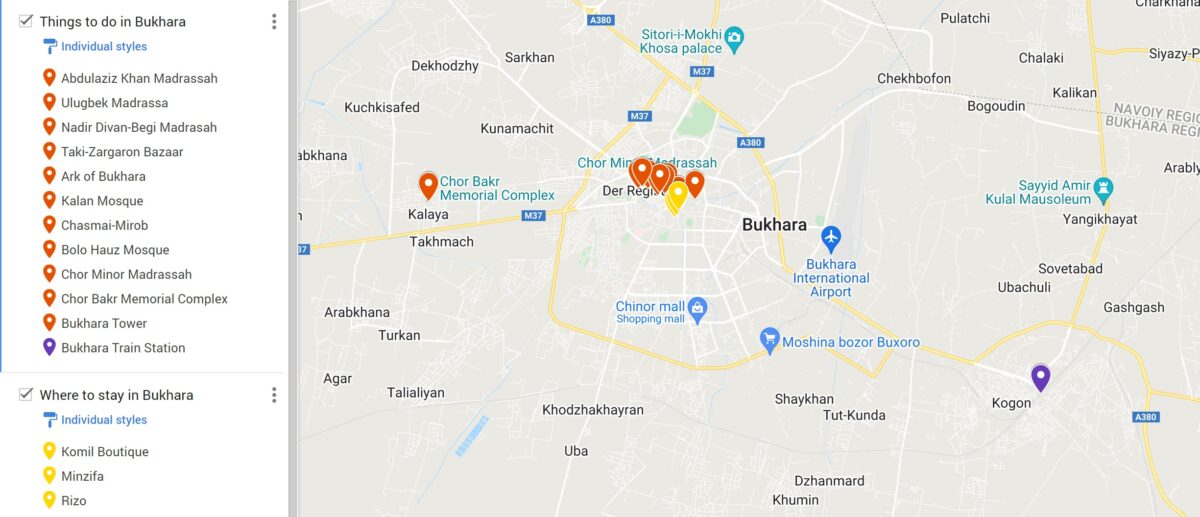
What to eat in Bukhara
On a very important side note, the water from the tap is not drinkable in the city! Due to the overuse of agrochemicals during Soviet times and the lack of water treatment plans the water has become non-drinkable.
Vegetarian food in Bukhara
Traditional Uzbekistan cuisine is quintessential Central Asian, a delicious mixture of Turkish, Chinese, Indian, and Persian. It is very heavy on the meat (shashlik or meat skewers are a local favorite), as a vegetarian myself I found it a little challenging at times. Luckily there is always rice, noodles, and local Bukhara bread (non) to fall back on.
A traditional thing to do in Bukhara is to finish your meal with a cup of steaming hot tea (choy) and a traditional Uzbek sweet as dessert.
Bukhara Restaurants
Cafe Chasmai Mirob: Offers a beautiful view over the Poi Kalon ensemble. The restaurant had a varied selection of vegetarian-friendly dishes.
BOLO HAUZ CHAIKANA: Located in the vicinity of the Bukhara Ark, this restaurant has a good selection of vegetarian-friendly dishes (salads, rice and soups)
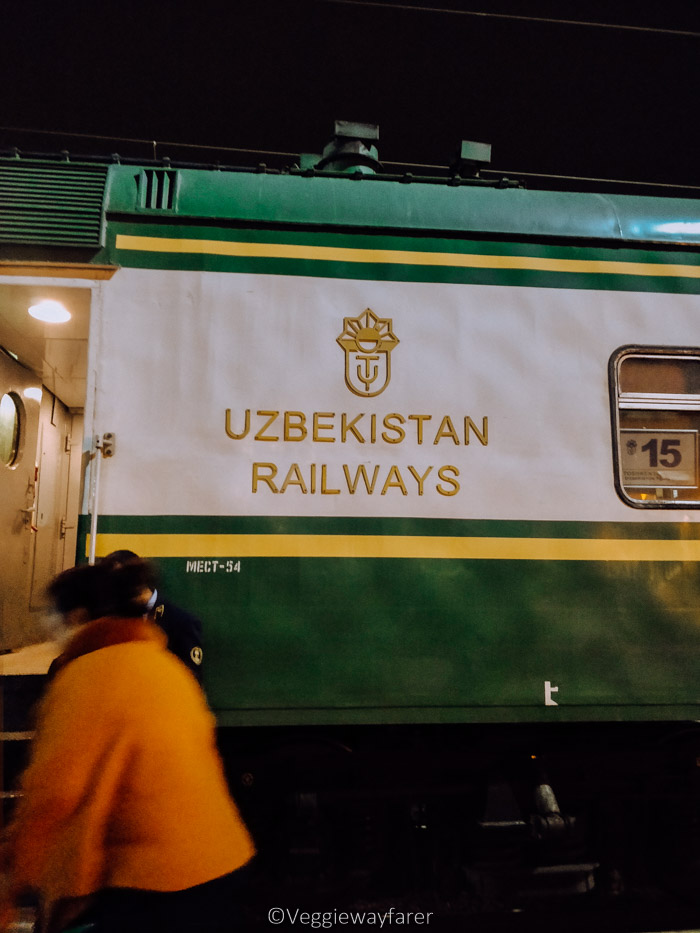

How to get to Bukhara
Traveling in and out of Bukhara from the main cities Tashkent, Khiva, and Samarkand is easy with the train. You will get into the main train station of Bukhara which is located in the newer part of the city (Kegan). Getting to old town in a taxi will take 20 minutes and should set you back no more than 20,000 UZS.
Tashkent to Bukhara
- Train: The direct train (high speed) from Tashkent to Bukhara runs multiple times a day. The journey takes 3.5 hours and costs around $8 USD. Purchase your ticket online or directly at the Khiva train station (cheapest option).
Khiva to Bukhara Train
- Train: Direct train from Khiva to Bukhara. Journey times vary depending on the type of train you take: High-speed trains will take 4 hours and a slow-speed train will take up to 7 hours. Prices range from $7 (slow train, 4th class) to $25 (first class fast train). Purchase your ticket online or directly at the Khiva train station (the cheapest option).
From Samarkand to Bukhara
- Train: Multiple trains a day run between Samarkand and Bukhara. You can opt for the high-speed train (1.5h) or the slow train (3.5h). Prices range from $7 to $16, depending on the type of train and the class of the ticket (first, second or third). Purchase your ticket online or directly at the Khiva train station (the cheapest option).
Bukhara travel budget split
Good news, your Bukhara holidays are going to be very budget-friendly.
HOTELS: Locally run hotels (boutique guesthouses) start at $25/night
RESTAURANTS: We paid between $6-$10 for a meal
ENTRANCE TICKETS: $15
TRANSPORTATION (train & taxi): $10
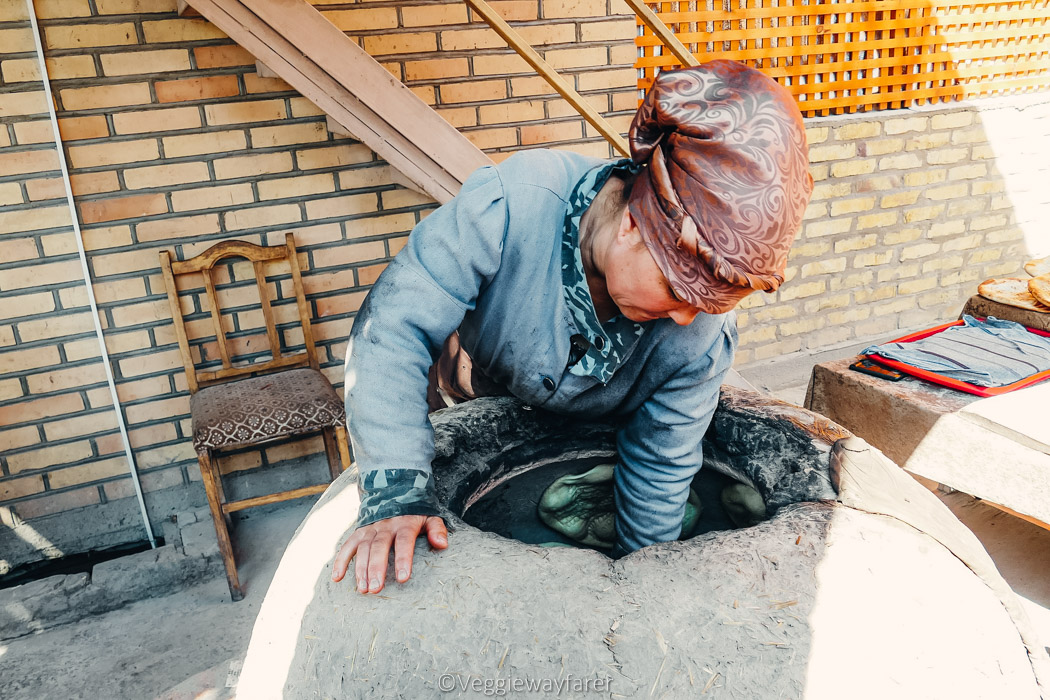
Bukhara itinerary travel tips
Before you visit Bukhara
- Bukhara Weather: Check out the average monthly rainfall and temperature before you go.
- Bukhara Population: Bukhara is the second-largest city in Uzbekistan with 1,500,000 people living in the city.
- Is Uzbekistan Safe: The locals are very friendly in all of Uzbekistan. We did not feel unsafe for a minute, not even when traveling on the night train.
During your visit in Bukhara
- Getting around Bukhara: Old Bukhara is small enough to be able to get around on foot. The monuments outside of town can be reached by taxi
- Payment in Bukhara: Cash is the only method of payment
- What to bring: If you are traveling in summer, make sure to bring a scarf to be able to cover your shoulders and knees. If you are traveling in winter, make sure to bring a lot of warm clothes (it gets very cold!)

Things to do in Bukhara in conclusion
There is plenty to explore both in and around Bukhara. The little town feels slightly more authentic than Khiva and gets a lot less footfall than Samarkand yet has a history that is just as illustrious. Bukhara is the perfect spot to delve into the history of Uzbekistan. Spend two days traipsing around the tile-clad monuments and fill your belly with the delicious local Plov.
ADDITIONAL RESOURCES FOR TRAVEL IN ASIA
Most beautiful places in Uzbekistan
Comprehensive guide to visiting Samarkand
Everything you need to know to explore Khiva
A complete guide to 2 weeks in Iran

Two days in Bukhara: Pin it







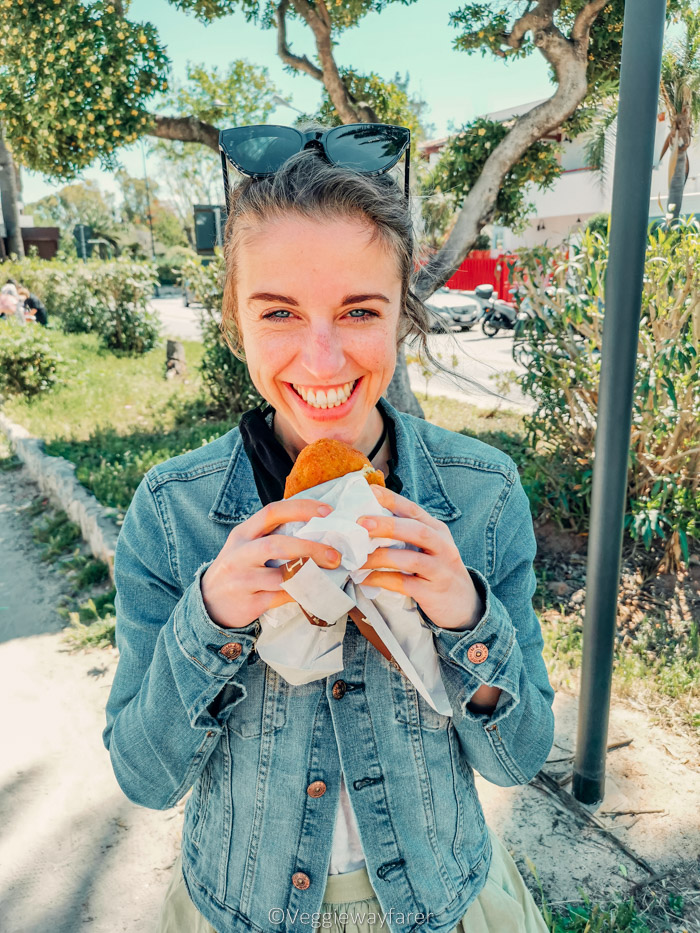
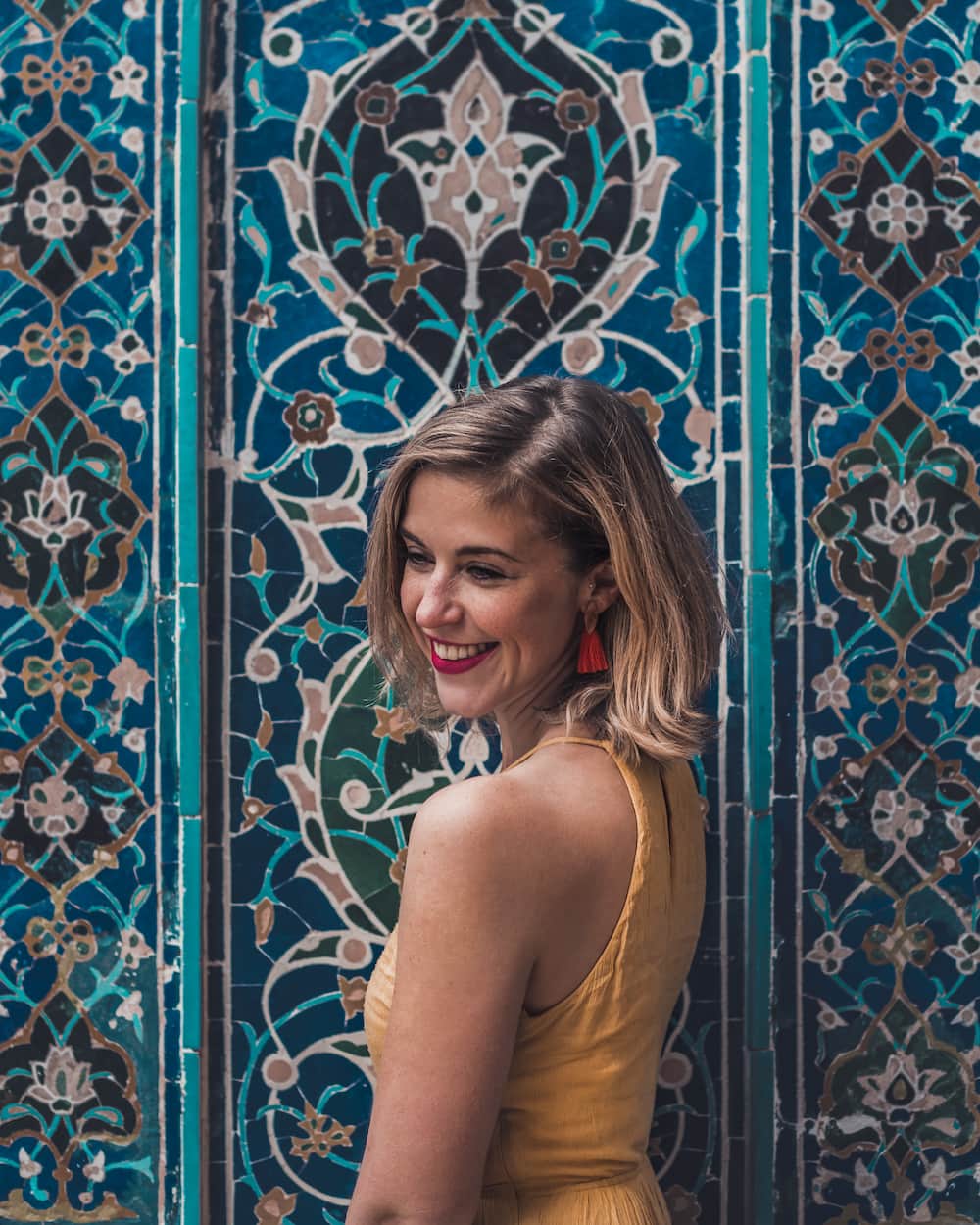

0 Comments